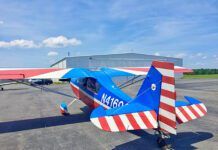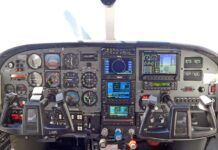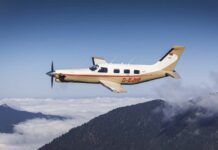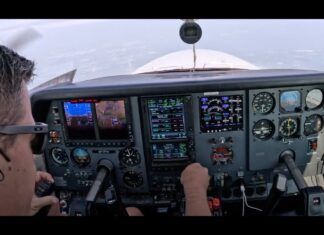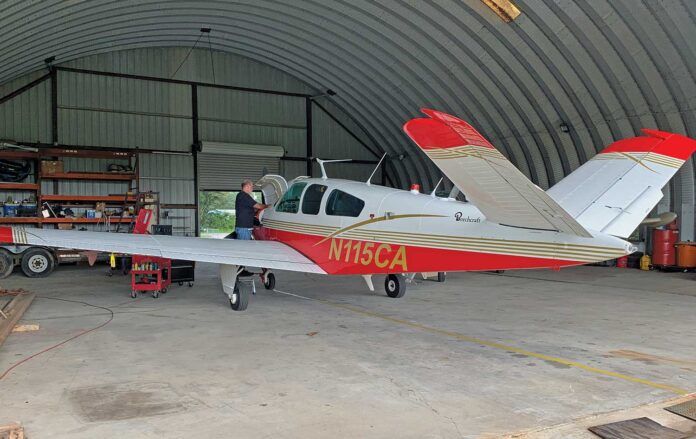
Over the years I’ve learned a few things about saving money during airplane ownership. Informed buyers start with a solid understanding of the airframe and engine’s limitations, plus are we’ll aware of the plane’s prior maintenance history. They fly it in a way that doesn’t cause premature engine and airframe failures, while accepting that despite doing everything right, complex and high-performance models will be more expensive to keep in the air than basic ones.
No aircraft is perfect, but you should pick one that’s close to perfect for your skills, budget and mission. That’s not always easy. In hopes of passing on some money-saving good habits, I’ll share some of my own ownership experiences and things I’ve done that have saved me enough dough to keep nice airplanes in the air for a long time.
Partners, charity
Times sure have changed since I bought a new Cessna Skylane in 1973. My brother and I paid $28,500 for the plane ($197,567 with today’s inflation), which at the time had state-of-the-art analog IFR King avionics. We operated as a split-everything partnership and from the beginning it seemed like a great way to save money. And even more important, we both had good piloting skills, understood engine operation and flew with the same engine management and flying techniques. These in-sync partnerships aren’t easy to come by. Then we tried to save more money and leased it back to a flight school. But 1300 flight hours came on quickly and so did an engine overhaul.
When our airplane was being rented or down for maintenance, we had to get our own rental. Finally, after several years of broken wheel pants and other typical flight-line prangs, we decided we had enough of renters and pulled it off the leaseback—no more broken wheel pants. Accept that working airplanes live tough lives in flight school rental fleets.
That aside, the leaseback had another dollar perk because it made flying into a tax benefit. It was essentially a rental property and as such you get to deduct the non-cash expense of depreciation. However, one of the rules of good money management is that each deal you invest in should be about making money first, not the tax write-off.
Using the airplane for business or charity has definite advantages. For that, plan on keeping good records (where you flew, who you visited with it and why—those kinds of things), plus it should be for a legitimate business purpose, of course. I know a Citation jet owner who bought a few rental properties where he liked to travel and that created a business use. The absolute first step is talking to your tax pro for what’s necessary to create a business or charitable use of the airplane, plus the record-keeping that’s required.
A few years after we bought the Skylane, my brother and I bought a Cessna T210 (back in a market when airplanes depreciated). There was no leaseback, but my brother started flying with the Flying Samaritans to Baja to perform charitable dentistry in makeshift clinics. He flew that trip monthly to different towns in Baja. And I used the T210 for local business flying, so we did get some tax benefits from our legit business flying.
The right airplane
That’s really the first step in saving money and for the lucky ones, the right airplane might be a new one. As with our new Skylane, the new Centurion was bulletproof with little extra maintenance other than annuals (except for either our mechanic leaving a nut in the turbo intake or a weld breaking, causing foreign object damage to the compressor turbine). But other than the turbo issue, for that airplane it was simply getting thorough annuals with a little extra attention on the landing gear. Point is, the big advantage of new airplanes is there generally aren’t many hidden problems. Everything starts fresh.
With the T210, my brother and I would help with the annuals by opening the inspection plates and helping with the reassembly. It saved a few hours and we got to know our bird a bit better. Consider owner-assisted annuals if your shop or mechanic will entertain it. Some don’t, while others welcome it.
A lot of buyers end up with wrong airplanes because they didn’t deeply research the model they thought they wanted. Surprises in maintenance, performance and insurability are all points to consider carefully. You can lose a fortune.
Frankly, what helped me when shopping for my first used airplane, a Beech V-Tail Bonanza (after mainly only flying Cessnas), was this magazine. The first thing I did was read everything Aviation Consumer wrote about it. The magazine goes back over 50 years and since most of us fly older airplanes, the older Used Aircraft Guide reports are still quite relevant and a great source of information and understanding of the model you’re considering. I joined ABS (American Bonanza Society) and talked extensively to the biggest knowledge source available, the late Norman Colvin. I bought and read his book, Colvin’s Clinic, along with John Eckalbar’s book, Flying the Beechcraft Bonanza.
A focused search
If possible, go for a flight or two in the model you’re considering and observe how the owner flies it. If you’ll fly passengers, sit in the back so you have an idea of how comfortable the cabin is. We made several flights in the rear seat with those owners and learned that it was actually comfortable back there. Organize and customize and think about what you prefer for systems. Similar models can vary widely with systems, including engine type.
For my Bonanza hunt, I zeroed in on the later models, mainly the V35B, and I preferred a 28-volt model, which started production late in 1978. It had a much quicker, four-second gear retraction and extension cycle. I created a loose-leaf search book with information on about 30 Bonanzas for sale with photos, equipment lists, notes and logbooks. Narrow your search from there.
After studying the information, talking to owners, talking to mechanics and of course discussing everything with my brother, I had a list of about six airplanes numbered first choice to sixth. Instead of a prepurchase evaluation, we did an extensive annual inspection and the airplane came out clean. At our next annual, we did some avionics and panel upgrades, including a copilot AI and DG on the right side. Our mechanic said it looked brand-new when he opened it up. We also added GAMIjectors to the engine, which make it possible to operate lean of peak.
Also think about storage—including the climate—and how often you’ll fly the aircraft. We hangared the aircraft and flew it often, meaning at least two times a month, and it fared we’ll in the dry Southern California climate, having no issues other than routine maintenance (two cylinders were overhauled in that period) for the first 900 hours until it came time at about 2200 hours for a new engine. My brother and another partner owned the airplane then and opted to upgrade to a remanufactured Continental IO-550 mod.
If you were to amortize the cost of the 550 over 900 hundred hours it worked out to be about $45 per hour for the period of ownership, which was about nine years until the engine change, including the STC. With engine costs substantially increasing these days, look carefully at these hourly costs and plan accordingly. Hangar costs ran from $200 to $350 a month during the 18 years of ownership. Insurance was about $1800 a year for $1 million smooth. Don’t forget to increase the hull value afterupgrades, including avionics retrofits.
Flyin’ it right
And that also includes having a plan for regular and unexpected maintenance. Knowing your mechanic or shop is as important as knowing the airplane. When the shop recommends repairs (or deferring them), understanding what you approve or don’t approve is critical. Get quotes and estimates. Most mechanics talk in hours, so know the hourly rate. Don’t be afraid to shop the shop.
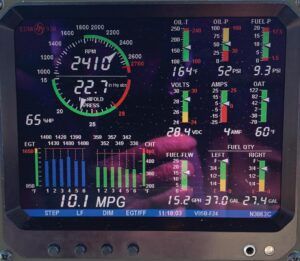
For a new-to-you airplane, accept that the first annual inspection (or the first couple, depending on the complexity of the airplane) will be the most intensive and expensive. The squawk list can be extensive with aircraft that got behind on maintenance.
That first annual on our Bonanza with a new GPS and some other upgrades to the panel cost about $10,000. But after that first annual, the others averaged $1500 to $2000 a year, with no significant maintenance (except for a couple of cylinders) plus oil changes in between. The only other operating expenses were fuel and food. You can be strategic. Every time we flew to Chino, California, to walk the warbird hangars and eat at Flo’s Airport Cafe, the famous diner right outside the gate at the gas pumps, we took advantage of cheaper 100LL.
Part of the reason our Beech V35B was relatively inexpensive to maintain was because we flew it with lots of attention paid to engine management and flying technique. That meant easier maintenance. As one example, our V35B had a landing gear speed of 152 knots, but we had a rule—no cycling the landing gear until 125 knots. We always planned our climbouts and descents accordingly.
The largest and most expensive mechanical device in an airplane is usually the engine (unless you’re flying with a Norden bombsight). Think big, heat-producing air pump. Consider that another word for energy is heat and it’s large amounts of heat that create the power to turn the propeller. Unfortunately, it’s heat that destroys engines, especially massive and abrupt changes in heat in the cylinder heads. This is where a lot of pilots go wrong in preserving the engine’s life (and sometimes, their own).
Run the numbers. A $50,000 overhaul every 1000 hours is twice as expensive as a 2000-hour overhaul. It amounts to a sizable per-hour difference, not to mention the additional shop downtime.
Flying at higher power settings makes more heat. Climbing at shallower rates gives you more speed over the ground and cooler cylinders and it usually offers better visibility out the windshield. Flying at higher altitudes generally means cooler temps outside and adds to efficiency. When I fly at 11,500 feet, the OAT is right around freezing (no visible moisture), the engine is set at full throttle and using good leaning techniques, still makes nearly 60 percent power. The engine is loafing along, with cylinder heads running between 300 and 350 degrees F.
Slow down, go high, sip less
GAMIjectors fuel injector nozzles (I’ve had them in every plane I’ve owned) make for a smoother running engine, which could mean a longer life. You can also fly lean of peak, especially at 65 percent power or less at altitude. And that makes for less fuel flow—and less heat. You fly slower by a half-dozen knots or so, but the overall miles per gallon goes up a bit. In the V35B with the IO-550 engine, we often flew in the mid-teens at a TAS of 155 knots, lean of peak at 10 GPH. In my current V35B with GAMIs at full throttle, I burn 12.5 GPH and indicate around 148 knots (175 true at 11,500 feet) with the mixture slightly rich of peak.
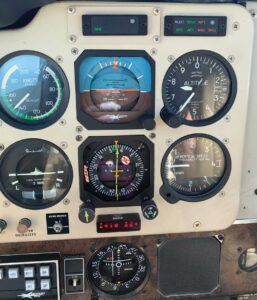
On a descent, I’ll come down at 300 FPM, readjusting the power and mixture every 1000 feet to keep the speed up and temps warm. Climbouts are done shallower, using initially 75 percent power, climbing at 120 knots and 600 FPM. If CHTs go up, my climb angle goes down and I open the cowl flaps and perhaps enrichen the mixture by 1 GPH. Also, winds aloft are obviously a big factor in determining cruise altitudes, so pick the best one that the weather and ATC will accommodate.
While not as significant, weight slows you down, maybe a knot per hundred pounds. Don’t fly with stuff you don’t need. On landing, when able use the whole runway and let the airplane roll out without using brakes. It saves tires, too. On takeoffs, put the power in smoothly and slowly. On a 10,000-foot runway, I’ll accelerate the airplane to flying speed without ever getting to full power (especially when light), there is no power reduction for the climb and I’m at 1500 feet before the end of the runway. Fixed-pitch props use full power.
Also be mindful of flap speeds. I use 130 knots max for approach flaps even though Vfe is around 150 knots. Full flaps are about 122 knots, but I use 100 knots as a max deployment speed. Bonanzas have a cracking nose rib problem on the right-hand flap actuator attachment bracket. And the repair can be expensive—$2500 or more. This might be more from too many people stepping on the flap than from overstressing on extension. Still, we are flying old airplanes with histories most of us don’t know. Why lower the gear and flaps at speeds higher than necessary?
These are ways of reducing maintenance and repair, while staying we’ll ahead of the airplane. And it also makes for better stabilized approaches for landing—and well-managed airspeeds make for smooth landings that don’t beat up the airplane.
I also learned that new paint can mean more speed. After a paint job and more modern interior in my Beech Baron, my performance record- keeping showed it was 3 knots faster.
Flight log, keep it savvy
On every flight where cruising altitude was attained, in a notebook I write down in columns the date, the destination, the cruising altitude, the OAT, the IAS, the power setting, the fuel flow, the CHTs, the EGTs, the oil temp, the oil pressure and volts. The record is continuous and can be trending, possibly indicating a problem before it becomes serious.
Some parting points for emphasis. For maintenance, invest in a service manual and learn what tasks are necessary. In Part 91 operations, engine TBOs are only manufacturers’ recommendations. Know your mechanic and know how to shop. Some understanding will tell you when hourly labor quotes are outrageous. Always know what and why something is being done to your airplane. Start with buying one with thorough maintenance logs (and FAA 337s), and don’t buy an orphan with little parts or field serviceability. The same with obsolete avionics.
Find a trusted insurance agent, especially in the current hard market, and don’t buy anything until you are certain that insurance is sustainable.
Last, keep exceptionally detailed records. This can save you money and make you more of it when you sell the plane. These records are irreplaceable. As Jorge Santayana once said, “Those who cannot remember the past are condemned to repeat it.”

